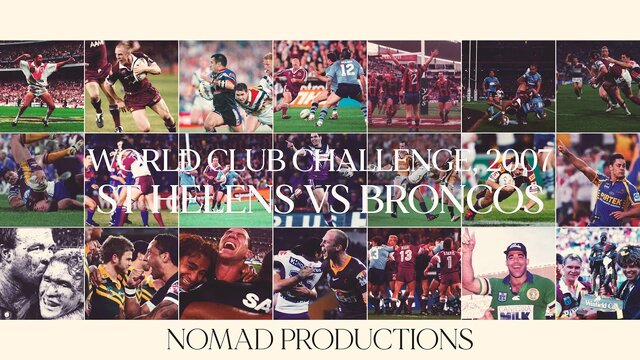- Apr 26, 2008
- 34,578
- 35,551
At the halfway mark of the season, the NRL is set to eclipse the AFL as the most watched football code on TV in 2018. If current trends continue, the NRL will have a higher premiership season audience than the AFL for the first time since 2011.
The Oztam ratings relate only to club games in both codes and, with State of Origin matches always represented in the top five most watched programs on TV, rugby league is headed for a historic season.
The quality of play in both codes has its critics, with NRL games too stop-start via a referee blitz and AFL games marred by congestion at the ball, resulting in scoring being the lowest in 50 years.
However, most NRL games are decided in the final minutes, while the result of many AFL games is determined by the beginning of the final quarter.
Rugby league’s dominance occurs at a time cumulative TV ratings in the Australian market have experienced a disturbing 8.9 percent decline for the first half of 2018.
Compared to 2017, AFL TV ratings are falling even faster ... down 13.9 percent to the end of round 9, while the NRL season, which began two weeks earlier, has recorded a drop of only 0.6 percent to the end of round 11.
Significantly, comparing TV time slots where NRL games are shown, with programs on other networks, the overall national TV market is down 4.7 percent, meaning NRL is holding its ground.
The cumulative live audience for NRL games in Australia has been 43.0 million for the first 11 Rounds, compared to 43.3m last year. The AFL’s cumulative live audience is 36.9m for its first 9 rounds, compared to 42.9m last year.
The average free-to-air Audience for the NRL is 612,689 in 2018, compared to 317,003 for the AFL. The AFL will say that it has cross-over timeslots and doesn’t go free to air with the same games nationally, but the raw numbers show that NRL is dominant.
The average subscription TV audience (Foxtel) for the NRL is 244,853 in 2018, compared to 180,387 for the AFL. The TV data confirms what State of Origin has demonstrated this past decade – Queensland is a rugby league state.
The Broncos are the highest-watched team across the NRL and AFL nationally (744,103 average free-to-air and 274,619 average subscription), while the North Queensland Cowboys rate third for free-to-air (722,922 average) and fourth for subscription TV (258,826 average). This is despite the Broncos' erratic form and the Cowboys' lowly position on the premiership ladder. The two lowest-watched teams nationally (across both AFL and NRL) are the AFL’s two Queensland teams, the Gold Coast Suns (93,510 FTA average and 97,765 subscription average) and Brisbane Lions (95,510 FTA average and 97,765 subscription average). They are the least popular of 34 teams across both codes.
The average Queensland-wide audience of the Broncos (325,494 per game) and Cowboys (311,321 per game) is nearly 10 times the size of the Queensland-wide audience of the Brisbane Lions (40,778 per game) or the Gold Coast Suns (34,365 per game)
Regional NSW rugby league fans remain loyal to the code, with overall viewership up 2 percent in northern NSW and up 6 percent in southern NSW, helping to offset some of the slight declines in metro market. Sydney is down 1 percent overall but Sydney is up 3.3 percent on free-to-air.
The early-season resurgence of the New Zealand Warriors is reflected in the viewership- up 13.4 percent on last year in Australia and up 9 percent in New Zealnd on Sky. Total viewership of NRL on Sky in New Zealand is up by 18 percent. Given the disenchantment with Super Rugby, the once impregnable fortress of the NZRU may be concerned.
The AFL’s Melbourne market has been particularly hard hit by the trend towards streaming services like Netflix, as well as strong Commonwealth Games viewership. AFL is down by 17.5 percent overall in its heartland market. By comparison, the NRL is up by 2 percent overall in Melbourne and the NRL’s free to air viewership in Melbourne is up by 11.2 percent. The Storm’s viewership ranks second out of all NRL or AFL Clubs nationally on free to air, with an average audience of 734,597. By comparison, the most viewed AFL Club is the Hawthorn Hawks with an average free to air audience of 558,234.
Rugby Australia’s closure of the Western Force, together with the NRL’s decision to open the 2018 season with a double header at Perth’s new stadium, has seen a 17 percent increase in overall viewership in Perth over the first half of 2018 to 860,245 cumulative viewers. Free-to-air is up 37.5 percent in Perth. By comparison, the AFL is down by 8 percent overall in the Perth market.
Insofar as both NRL and AFL receive approximately the same revenue from broadcasters on a per game basis, Rugby League Central would be wishing 2018 was the last year of its current deal, rather than the first.
Source: The Sydney Morning Herald
The Oztam ratings relate only to club games in both codes and, with State of Origin matches always represented in the top five most watched programs on TV, rugby league is headed for a historic season.
The quality of play in both codes has its critics, with NRL games too stop-start via a referee blitz and AFL games marred by congestion at the ball, resulting in scoring being the lowest in 50 years.
However, most NRL games are decided in the final minutes, while the result of many AFL games is determined by the beginning of the final quarter.
Rugby league’s dominance occurs at a time cumulative TV ratings in the Australian market have experienced a disturbing 8.9 percent decline for the first half of 2018.
Compared to 2017, AFL TV ratings are falling even faster ... down 13.9 percent to the end of round 9, while the NRL season, which began two weeks earlier, has recorded a drop of only 0.6 percent to the end of round 11.
Significantly, comparing TV time slots where NRL games are shown, with programs on other networks, the overall national TV market is down 4.7 percent, meaning NRL is holding its ground.
The cumulative live audience for NRL games in Australia has been 43.0 million for the first 11 Rounds, compared to 43.3m last year. The AFL’s cumulative live audience is 36.9m for its first 9 rounds, compared to 42.9m last year.
The average free-to-air Audience for the NRL is 612,689 in 2018, compared to 317,003 for the AFL. The AFL will say that it has cross-over timeslots and doesn’t go free to air with the same games nationally, but the raw numbers show that NRL is dominant.
The average subscription TV audience (Foxtel) for the NRL is 244,853 in 2018, compared to 180,387 for the AFL. The TV data confirms what State of Origin has demonstrated this past decade – Queensland is a rugby league state.
The Broncos are the highest-watched team across the NRL and AFL nationally (744,103 average free-to-air and 274,619 average subscription), while the North Queensland Cowboys rate third for free-to-air (722,922 average) and fourth for subscription TV (258,826 average). This is despite the Broncos' erratic form and the Cowboys' lowly position on the premiership ladder. The two lowest-watched teams nationally (across both AFL and NRL) are the AFL’s two Queensland teams, the Gold Coast Suns (93,510 FTA average and 97,765 subscription average) and Brisbane Lions (95,510 FTA average and 97,765 subscription average). They are the least popular of 34 teams across both codes.
The average Queensland-wide audience of the Broncos (325,494 per game) and Cowboys (311,321 per game) is nearly 10 times the size of the Queensland-wide audience of the Brisbane Lions (40,778 per game) or the Gold Coast Suns (34,365 per game)
Regional NSW rugby league fans remain loyal to the code, with overall viewership up 2 percent in northern NSW and up 6 percent in southern NSW, helping to offset some of the slight declines in metro market. Sydney is down 1 percent overall but Sydney is up 3.3 percent on free-to-air.
The early-season resurgence of the New Zealand Warriors is reflected in the viewership- up 13.4 percent on last year in Australia and up 9 percent in New Zealnd on Sky. Total viewership of NRL on Sky in New Zealand is up by 18 percent. Given the disenchantment with Super Rugby, the once impregnable fortress of the NZRU may be concerned.
The AFL’s Melbourne market has been particularly hard hit by the trend towards streaming services like Netflix, as well as strong Commonwealth Games viewership. AFL is down by 17.5 percent overall in its heartland market. By comparison, the NRL is up by 2 percent overall in Melbourne and the NRL’s free to air viewership in Melbourne is up by 11.2 percent. The Storm’s viewership ranks second out of all NRL or AFL Clubs nationally on free to air, with an average audience of 734,597. By comparison, the most viewed AFL Club is the Hawthorn Hawks with an average free to air audience of 558,234.
Rugby Australia’s closure of the Western Force, together with the NRL’s decision to open the 2018 season with a double header at Perth’s new stadium, has seen a 17 percent increase in overall viewership in Perth over the first half of 2018 to 860,245 cumulative viewers. Free-to-air is up 37.5 percent in Perth. By comparison, the AFL is down by 8 percent overall in the Perth market.
Insofar as both NRL and AFL receive approximately the same revenue from broadcasters on a per game basis, Rugby League Central would be wishing 2018 was the last year of its current deal, rather than the first.
Source: The Sydney Morning Herald

